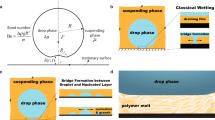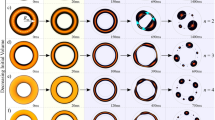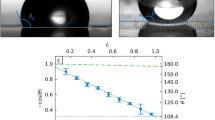Abstract
The controlled formation of micrometre-sized drops is of great importance to many technological applications1,2,3,4,5. Here we present a wetting-based destabilization mechanism of forced microfilaments on either hydrophilic or hydrophobic stripes that leads to the periodic emission of droplets. The drop emission mechanism is triggered above the maximum critical forcing at which wetting, capillarity, viscous friction and gravity can balance to sustain a stable driven contact line. The corresponding critical filament velocity is predicted as a function of the static wetting angle, which can be tuned through the substrate behaviour, and shows a strong dependence on the filament size. This sensitivity explains the qualitative difference in the critical velocity between hydrophilic and hydrophobic stripes, and accounts for previous experimental results of splashing solids6. We demonstrate that this mechanism can be used to control independently the drop size and emission period, opening the possibility of highly monodisperse and flexible drop production techniques in open microfluidic geometries.
This is a preview of subscription content, access via your institution
Access options
Subscribe to this journal
Receive 12 print issues and online access
$259.00 per year
only $21.58 per issue
Buy this article
- Purchase on Springer Link
- Instant access to full article PDF
Prices may be subject to local taxes which are calculated during checkout





Similar content being viewed by others
References
Atencia, J. & Beebe, D. J. Controlled microfluidic interfaces. Nature 437, 648–655 (2005).
Song, H., Chen, D. L. & Ismagilov, F. Reactions in droplets in microfluidic channels. Angew. Chem. Int. Ed. 45, 7336–7356 (2006).
Song, H., Tice, J. D. & Ismagilov, F. A microfluidic system for controlling reaction networks in time. Angew. Chem. Int. Ed. 42, 767–772 (2003).
Edd, J. F. et al. Controlled encapsulation of single-cells into monodisperse picolitre drops. Lab Chip 8, 1262–1264 (2008).
Prakash, M. & Gershenfeld, N. Microfluidic bubble logic. Science 315, 832–835 (2007).
Duez, C., Ybert, C., Clanet, C. & Bocquet, L. Making a splash with water repellency. Nature Phys. 3, 180–183 (2007).
Anna, S. L., Bontoux, N. & Stone, H. A. Formation of dispersions using ‘flow focusing’ in microchannels. Appl. Phys. Lett. 82, 364–366 (2003).
Link, D. R., Anna, S. L., Weitz, D. A. & Stone, H. A. Geometrically mediated breakup of drops in microfluidic devices. Phys. Rev. Lett. 92, 054503 (2004).
Xu, J. H., Luo, G. S., Li, S. W. & Chen, G. G. Shear force induced monodisperse droplet formation in a microfluidic device by controlling wetting properties. Lab Chip 6, 131–136 (2006).
Pannacci, N. et al. Equilibrium and nonequilibrium states in microfluidic double emulsions. Phys. Rev. Lett. 101, 164502 (2008).
Kataoka, D. E. & Troian, S. M. Patterning liquid flow at the microscopic scale. Nature 402, 794–797 (1999).
Rauscher, M., Dietrich, S. & Koplik, J. Shear flow pumping in open micro- and nanofluidic systems. Phys. Rev. Lett. 98, 224504 (2007).
Bonn, D., Eggers, J., Indekeu, J., Meunier, J. & Rolley, E. Wetting and spreading. Rev. Mod. Phys. 81, 739–805 (2009).
Snoejier, J. H., Ziegler, J., Andreotti, B., Fermigier, M. & Eggers, J. Thick films of viscous fluid coating a plate withdrawn from a liquid reservoir. Phys. Rev. Lett. 100, 244502 (2008).
Sebilleu, J., Limat, L. & Eggers, J. Flow separation from a stationary meniscus. J. Fluid Mech. 633, 137 (2009).
Succi, S. The Lattice Boltzmann Equation for Fluid Dynamics and Beyond (Oxford Univ. Press, 2001).
Eggers, J. Hydrodynamic theory of forced dewetting. Phys. Rev. Lett. 93, 094502 (2004).
Aarts, D. G. A. L., Schmidt, M. & Lekkerkerker, H. N. W. Direct visual observation of thermal capillary waves. Science 304, 847–850 (2004).
Qian, T., Wang, X-P. & Sheng, P. A variational approach to moving contact line hydrodynamics. J. Fluid Mech. 564, 333–360 (2006).
Chevalier, C., Ben Amar, M., Bonn, D. & Lindner, A. Inertial effects on Saffman–Taylor viscous fingering. J. Fluid Mech. 552, 83–97 (2006).
Duez, C., Ybert, C., Clanet, C. & Bocquet, L. Wetting controls separation of inertial flows from solid surfaces. Phys. Rev. Lett. 104, 084503 (2010).
Ohzono, T., Monobe, H., Shiokawa, K., Fujiwara, M. & Shimizu, Y. Shaping liquid on a micrometre scale using microwrinkles as deformable open channel capillaries. Soft Matter 5, 4658–4664 (2009).
Cubaud, T. Wetting and lubricating film instabilities in microchannels. Phys. Fluids 21, 091103 (2009).
Acknowledgements
We are grateful to the authors of ref. 6 for kindly providing their experimental data and for useful discussions, to G. McHale for providing superhydrophobic cards and to A. Cabot and J. Yeomans for useful discussions. We acknowledge financial support from Dirección General de Investigación (Spain) under projects FIS 2009-12964-C05-02 and FIS 2008-04386, and DURSI projects SGR2009-00014 and SGR2009-634. R.L-A. acknowledges support from Conacyt (Mexico), Fundación Carolina (Spain) and EPSRC grant EP/D050952/1. The computational work herein was carried out in the MareNostrum Supercomputer at Barcelona Supercomputing Center.
Author information
Authors and Affiliations
Contributions
R.L-A., A.H-M. and I.P. planned the research, developed the theoretical model and experimental design, carried out data analysis and interpretation, and wrote the manuscript. R.L-A. carried out the numerical simulations. R.N. carried out the microfluidic experiments, and processed and analysed the experimental data.
Corresponding author
Ethics declarations
Competing interests
The authors declare no competing financial interests.
Supplementary information
Supplementary Information
Supplementary Information (PDF 528 kb)
Supplementary Movie
Supplementary Movie (AVI 7131 kb)
Supplementary Movie
Supplementary Movie (AVI 3781 kb)
Supplementary Movie
Supplementary Movie (AVI 5247 kb)
Supplementary Movie
Supplementary Movie (MPG 200 kb)
Supplementary Movie
Supplementary Movie (MPG 198 kb)
Rights and permissions
About this article
Cite this article
Ledesma-Aguilar, R., Nistal, R., Hernández-Machado, A. et al. Controlled drop emission by wetting properties in driven liquid filaments. Nature Mater 10, 367–371 (2011). https://doi.org/10.1038/nmat2998
Received:
Accepted:
Published:
Issue Date:
DOI: https://doi.org/10.1038/nmat2998
This article is cited by
-
Kirigami fog nets: how strips improve water collection
npj Clean Water (2023)
-
Efficient agricultural drip irrigation inspired by fig leaf morphology
Nature Communications (2023)
-
In situ reversible underwater superwetting transition by electrochemical atomic alternation
Nature Communications (2019)
-
Light-induced dynamic shaping and self-division of multipodal polyelectrolyte-surfactant microarchitectures via azobenzene photomechanics
Scientific Reports (2017)
-
Reducing the contact time using macro anisotropic superhydrophobic surfaces — effect of parallel wire spacing on the drop impact
NPG Asia Materials (2017)



